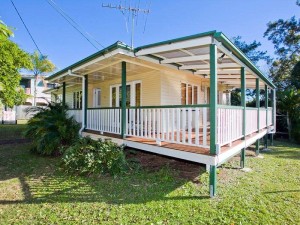by Jacob Aldridge, who owns ~$1.2 million in property and loves every cent of his mortgages
I like money and I like property. I mean, they’re not the reason I’m alive but all other things being equal I would rather have them than not. Which is why I get angry when my first-home-owner-wannabe friends outline strategies to avoid paying mortgage insurance, and I get angrier still when that strategy is fully supported by financial advisers.
Want to make money in property? Pay the damn LMI!
(And don’t take property investment advice from financial advisers who only make money when you invest in shares.)
Why? Because Math
My beautiful wife and I bought our first home together (I had previously owned a unit) in Brisbane Australia, in late 2006 for $360,000. It was 8kms from the Brisbane CBD, and some friends said we were mad paying that much! Some readers tune out at this point because they may have to pay double that, but keep in mind we were earning about $45,000 each per annum, and had saved about $20,000.

After other costs (like conveyancing) that we paid from that cash, this meant a Loan to Value Ratio (LVR – the percentage we borrowed) of more than 95%. And since Lenders Mortgage Insurance (LMI) kicks in at LVRs above 80% that meant we paid it. We paid ING Bank their Mortgage Insurance Premium of $8,812.80.
Actually, worse still, we capitalised that $8,812 (ie, rolled it into the home loan), meaning it will cost us $17,000 over the life of the mortgage. Surely we were fools for gifting that money to the bank?!
I think a lot of “never pay LMI” crowd are doing their sums this way:
Options (a) Pay LMI (b) No LMI
Price $360,000 $360,000
LVR 95% 80%
LMI $8,812 $0
Owed $350,812 $288,000
Value $360,000 $360,000
Net $9,188 $72,000
In this example, not only do you save $8,812 by not paying LMI – you are $54,000 ahead because of your larger deposit. And that’s why it’s magic fairyland math – it works on the assumption that you have this lazy $54,000 lying around and a choice about whether to apply it to your deposit or not. But in reality, it takes time to save that kind of money; and since property prices change over time, this is a false comparison.
it’s magic fairyland math … a false comparison
Self Insurance
I’ll divert at this point to note why banks charge LMI and why banks in Australia generally report annual profits in the many billions of dollars.
Why do they charge it? Ostensibly, because property values can fluctuate and this protects them against you defaulting on your mortgage and them having to sell the house for less than they are owed. In reality? They charge this because they can.
And many banks (not all) actually “Self Insure”. In other words, you aren’t buying an insurance policy with that money and the bank isn’t incurring a cost. They are just taking your money as an upfront fee.

I Pity The Fool
In the LMI payment game, I pity the fool – the fool who doesn’t pay it.
Here, for an example of what I call BAD Finance Advice, is Olivia Maragna on the topic of LMI: “it is worth your while waiting until you have enough saved or enough equity in another property to allow you to avoid this insurance.”
Fast forward 12 months on our first home, I spent some money on an engagement ring and so we had the bank refinance the house to help fund our wedding.
They revalued the house at $470,000.
So the real math was not the “pay LMI” v “not pay LMI” comparison above, it was the comparison of “buying now and paying LMI” v “buying later and not paying”. Had we waited “until we have enough saved…to avoid this insurance” we would have saved $8,812 … and spent $110,000 more on a house.
If you’re not sure which is bigger, $8,812 or $110,000, then property ownership probably isn’t for you.
We had friends who took this anti-LMI advice back then, and I’m still seeing some doing it today. All other things being equal, I’d rather not pay any fee I don’t have to, but in the world of property prices other things aren’t equal and you can find yourself losing $100,000 to save $10,000. Please don’t!
Here’s that data, simplified, in a table. I’m using a real example from my life, but the math is transferable.
Options (a) Buy Now, Pay LMI (b) Buy Later, No LMI
Price $360,000 $470,000
LVR 95% 80%
LMI $8,812 $0
Owed $350,812 $376,000
Value $470,000 $470,000
Net $119,188 $94,000
and importantly, this assumes you can actually save the additional 15% deposit in 12 months ($470,000 x 15% = $70,500 in this example).
Remember, our gross incomes combined at the time were about $90,000 – we weren’t even taking home $70,000 per annum let alone saving that amount. So Option (b) not only leaves you $25,000 worse off, it was actually an impossible option for my beautiful wife and me. So you end up saving for yet another year, and watching the prices outstrip your deposit again!
Australia is loaded with young people who could have bought a home 5 years ago, complaining that they can’t get onto the property ladder because they can’t save fast enough and they don’t want to pay LMI. In the past 18 months I’ve paid another $16,000 LMI and made another $60,000 in capital growth.
But Property Values Don’t Always Increase?
You are correct! Property investment lovers who claim ‘house prices always go up’ are another annoyance of mine, but less so. I believe the greatest return on investment you can realise is direct investment in private enterprises, but that’s a risk most people will never be willing to take. Home ownership is far more common, and as Alan Kohler pointed out today even investing your Super in housing may not be as silly as it first sounds.
So don’t rush into these decisions either (see Olivia’s good advice on doing market research). We went to contract on a house in 2009 which we crashed (termite damage). As an experience, that hurt, and as a consequence we reviewed our investment options. It was pretty clear to us that house prices in Brisbane weren’t going anywhere for a couple of years, so we moved to London and came back to the Australian property market in 2013.
If you don’t know what house prices in your area have done for the past 5 years, and what forecasters are saying for at least the next 2 years, then LMI is the least of your worries.
Key Learning: If you’re debating whether to buy that $800,000 property now, or wait 2 more years to save the deposit because LMI is terrible, please reconsider. You will NOT save $200,000 cash deposit in that time…but you may cost yourself that much in growth!
If you leave me, can I come too…? Click here to subscribe to my infrequent updates
If you’re Dustin Curtis, you should follow me on Twitter here.
And please tell your friends: Sharing is Caring
…


[…] ‘creating’ land for housing, which would be a boon for councils but less so for real estate investors. Will the transition away from everybody-needs-a-car mean more people willing to use existing […]